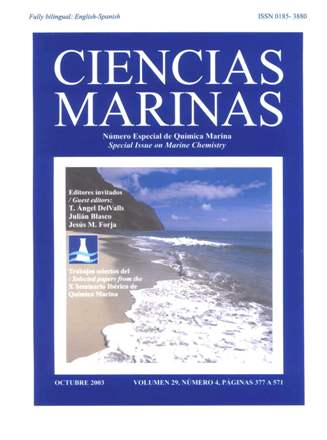Chemical speciation of dissolved lead in polluted environments. A case of study: the Pontevedra Ria (NW Spain)
Main Article Content
Abstract
Chemical speciation of dissolved lead was determined at four sampling sites in the Pontevedra Ría (NW Spain) by differential pulse anodic stripping voltammetry (DPASV) with a HMDE. Sampling location was chosen due to its evident anthropogenic influence: one sample was taken in the Lérez River mouth (2.2-salinity) and other three samples were taken in the surroundings of the village of Marín (salinity 30–32). Lead concentrations were 0.64 nM (river sample) and 4.8–21.9 nM (saline samples). Speciation results showed that organic chelates of lead, 88–95% of total dissolved lead, are the dominant species of the metal even at these high concentrations. Two types of lead organic complexing ligands were detected in all samples. The river water sample showed the presence of a strong ligand with a concentration of ~7 nM with a conditional stability constant of K'Pb-L1 ≥ 1011.1, and a weaker ligand (K'Pb-L2 = 108.2) with a concentration of 53.4 nM. The three saline samples showed similar behavior: a strong ligand (K'Pb-L1 ~ 108.6) with concentration ranging from 33.0 to 53.5 nM, and a weaker complexing ligand (K'Pb-L2 ~ 107.5) with concentration ranging from 32.6 to 50.5 nM. All lead-organic ligand complexes (except the strong complex in the river water sample) showed labile behavior in the time scale of the technique.
Downloads
Article Details
This is an open access article distributed under a Creative Commons Attribution 4.0 License, which allows you to share and adapt the work, as long as you give appropriate credit to the original author(s) and the source, provide a link to the Creative Commons license, and indicate if changes were made. Figures, tables and other elements in the article are included in the article’s CC BY 4.0 license, unless otherwise indicated. The journal title is protected by copyrights and not subject to this license. Full license deed can be viewed here.

